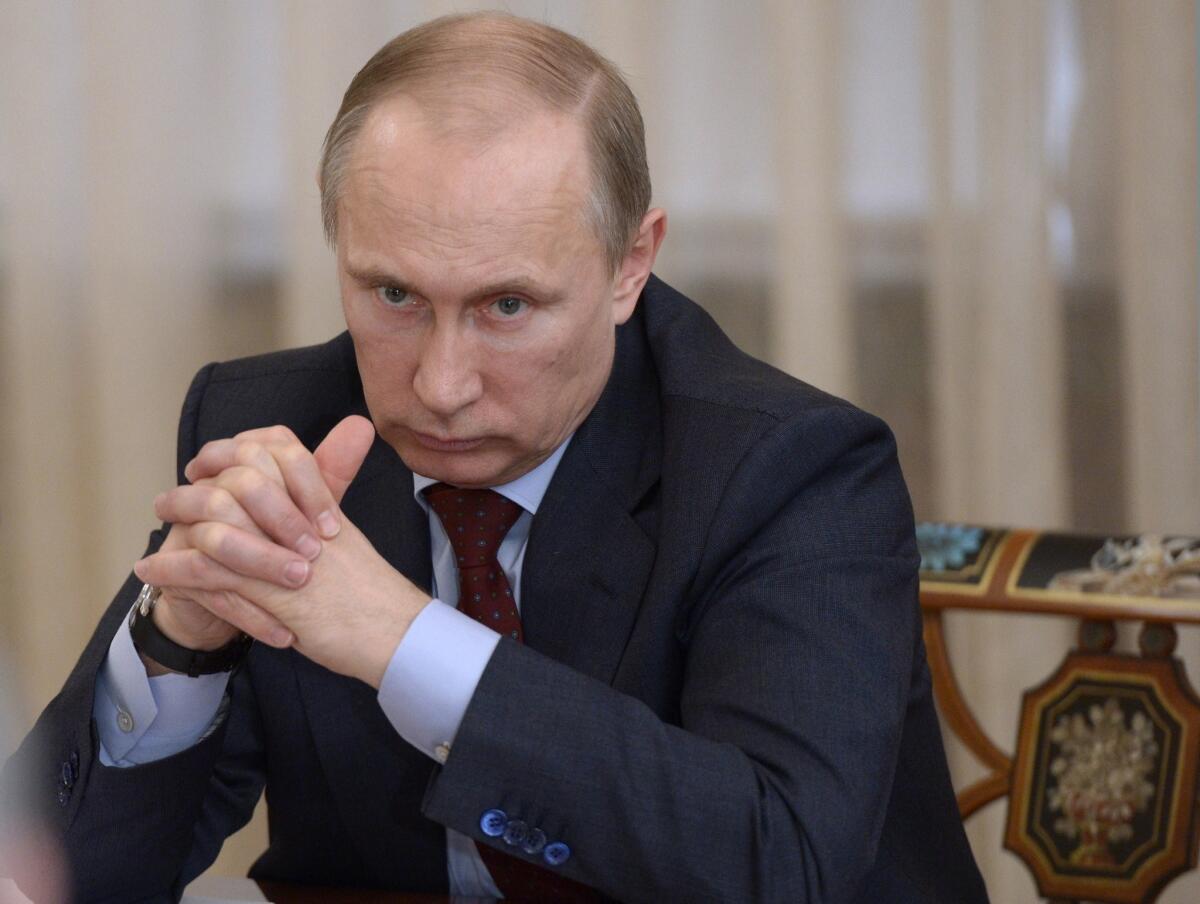Op-Ed: Beware the rise of Putin the Terrible

At the moment, our preoccupation is President Vladimir Putin’s next move outside Russia. Will he invade eastern Ukraine? Will he move into Moldova? But even more worrisome than these territorial issues is what Putin may have in mind for Russia itself.
The Russian president did not engineer the Ukrainian crisis, but he has exploited it to begin forging something far more dangerous than land grabs: namely, a political arrangement that could secure his rule of Russia for life. The annexation of Crimea has fueled nationalist hysteria and paranoia within Russia, and Putin has ridden that wave, reshaping his government into one that is far more repressive, ideologically driven, openly messianic and founded on a revisionist view of history that is explicitly anti-West and anti-American.
Putin heralded the birth of this new politics in an extraordinarily frank and disturbing nationally televised speech on March 18 to the Russian political elite. In it, he lamented the breakup of the Soviet Union, saying that “after the dissolution of bipolarity on the planet, we no longer have stability.” Since then, he said, the West, and the United States in particular, have preferred not to be “guided by international law in their practical policies but by the rule of the gun” and have been seeking to “drive Russia into the corner.”
PHOTOS: A peek inside 5 doomed dictators’ opulent lifestyles
This hostility toward the West, which Putin portrays as determined to victimize Russia, is not simply expedient and tactical. Rather, it has become Putin’s raison d’etre, shaping his decisions and offering a convenient justification for greater repression. Ultimately, perhaps, he will use it to justify his assumption of a lifelong office as Father of the Nation, Protector of all Russians and Defender of the Motherland. Meanwhile, anyone who opposes him is, in Putin’s words, part of the “fifth column” and a “traitor of the nation.”
The perils of such a future for Russia are many and obvious. But not least among them is that it would mark a return to a personality-driven dictatorship. The many ovations and chants that greeted Putin’s Kremlin appearance March 18 suggested a new cult of personality that is already enormous and might one day rival even that of Josef Stalin.
What makes this development not only alarming but potentially apocalyptic is the fact that Putin’s unpredictable, revisionist and clearly aggressive regime has access to about 1,700 strategic nuclear warheads deployed on more than 400 land- and submarine-based long-range strategic missiles. And, in an ongoing $770-billion, 10-year rearmament and modernization program, Russia has heightened the threat of those weapons with an upgraded intercontinental ballistic missile capable of carrying as many as 10 warheads, each of them independently targeted and designed explicitly to evade U.S. missile defenses.
Never before has a dictator with such a cult of personality had such access to these kinds of weapons. Stalin, as brutal and antagonistic to the West as he was, did not have missiles. Even the Soviet Union under Nikita Khrushchev had only short-range missiles. (It was his move to place them close enough to reach the United States that provoked the Cuban missile crisis.) And Khrushchev, for all his erratic aggressiveness, was definitely constrained by the Politboro elite, which in the end removed him from office, in part because of the Cuba escapade.
Mao Tse-tung had a bomb but no missiles. Leonid Brezhnev had long-range missiles, but his was definitely a collective leadership regime, overseen by the largely older, conservative and generally risk-averse Politburo. In North Korea today, Kim Jong Un is certainly a totalitarian leader with a god-like cult of personality, but he has only a handful of ICBMs whose reliability, range and precision are still uncertain. Finally, China is busily developing its long-range delivery vehicles, but its leader, at least for now, is selected — and largely controlled — by the elite. Moreover, he is rigidly limited to two five-year terms.
Since Western democracies have never confronted an aggressive personality-driven autocracy armed with strategic nuclear warheads, a response must be quickly improvised. The obvious first measure should be to commit all necessary resources to building a far more formidable strategic missile defense. This effort is doubly urgent because of a concerted effort on Moscow’s part to modernize its strategic missile forces. Another important move will be to increase the cost of the Putin dictatorship to Russia through sanctions and other policies.
But the most important thing of all right now is awareness. The U.S. and its allies must attune themselves to the distinct and highly malignant change in the Russian leadership, which has sharply escalated the danger Russia presents to the world.
Leon Aron is director of Russian studies at the American Enterprise Institute and the author, most recently, of “Roads to the Temple: Truth, Memory, Ideas, and Ideals in the Making of the Russian Revolution, 1987-1991.”
More to Read
Sign up for Essential California
The most important California stories and recommendations in your inbox every morning.
You may occasionally receive promotional content from the Los Angeles Times.










